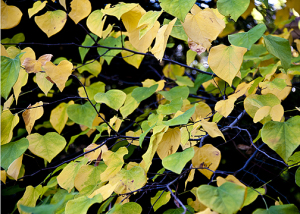Beauty Before The Storm

Chinese pistache (10/31/14) John Poimiroo
Northern California is braced for its first major storm of the coming winter. So, I took camera in hand this morning to photograph the exotic trees in my yard that are near peaking, to capture their beauty before the storm.
Chinese pistache (pistacia chinensis) is a slow-growing ornamental tree from China whose foliage turns day-glo orange to red with tones of yellow and green. Yesterday, I mentioned on Twitter that pistache have naturalized in Placerville.
Traveling through there on the way to Apple Hill, you see bright red balls of color at all of Placerville’s highway offramp areas. It is evident that many of these pistache trees are volunteers that are now populating forests in and around Placerville, in the same way exotic pink flowering oleander are doing beside the Sacramento River between Redding and Shasta Dam.

Eastern Redbud (10/31/14) John Poimiroo
Eastern redbud (cercis canadensis) are the fastest growing of redbuds and get 25 to 35 feet in height, according to the Sunset Western Garden Book. We get many compliments about our redbud in all seasons, though particularly enjoy it now, when its large heart-shaped leaves turn yellow and are mixed with lime-colored brethren.

Red Oak (10/31/14) John Poimiroo
Red oak (quercus rubra) is native to the east U.S. It’s a handsome tree in summer, magnificent in autumn, then carries brown leaves through winter. This is lovely with a dusting of snow, though it’s not my favorite winter coat on an oak.

Strawberry Tree (10/31/14) John Poimiroo
The Strawberry Tree (arbutus menziesii) is a madrone whose autumn branches dangle with brilliant orange to red berries. They’re delicious to the eye only.
El Dorado Hills (Near Peak – 50-75%) – Gardens and landscaped boulevards are near peak at 1,000 feet in the western Sierra foothills. GO NOW!
Apple Hill (Near Peak – 50-75%) – Apple orchards and vineyards surrounding Camino are full of golden, orange and brown color. GO NOW!
Placerville (Peak – 75-100%) – Exotic Chinese pistache are brightly crimson along US 50. GO NOW!






































![Plaza Park, Fair Oaks [iPhone] (10/25/14) John Poimiroo](http://www.californiafallcolor.com/wp-content/uploads/JP-Fair-Oaks-10-25-iPhone-300x225.jpg)
![Plaza Park, Fair Oaks [Nikon] (10/25/14) John Poimiroo](http://www.californiafallcolor.com/wp-content/uploads/JP-Plaza-Park-Fair-Oaks-10-25-300x214.jpg)
![40th Ave., [iPhone] (10/25/14) John Poimiroo](http://www.californiafallcolor.com/wp-content/uploads/JP-40th-Ave.-2-10-25-iPhone-300x225.jpg)
![40th Ave. [Nikon] (10/25/14) John Poimiroo](http://www.californiafallcolor.com/wp-content/uploads/JP-40th-Ave-10-25-300x214.jpg)
![William Land Park, Sacramento [iPhone] (10/25/14) John Poimiroo](http://www.californiafallcolor.com/wp-content/uploads/JP-Land-Park-10-25-iPhone-300x225.jpg)
![William Land Park, Sacramento [Nikon] (10/25/14) John Poimiroo](http://www.californiafallcolor.com/wp-content/uploads/JP-Land-Park-3-10-15-300x214.jpg)
